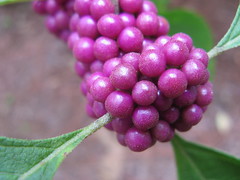
The American Beautyberry (callicarpa americana) lives up to its name: it is an outstanding shrub of the verbena family that loves northeast Florida so much it grows wild or cultivated with equal ease. Also known simply as beautyberry or French mulberry, this native plant is known for its characteristically eye-catching clusters of purple berries in the summer and fall months.
American Beautyberry responds well to transplanting and will propagate from seed or soft-wood cuttings in soil. Birds are known to eat the berries when there is not much else to eat in the colder months, but it is not their first choice for food. This is good thing so that the beautiful berries remain in the garden. Beautyberry leaves are a known food source for some caterpillars so they make a welcome addition to the a butterfly garden.
Currently in the Palm Coast, Ormond Beach, and St. Augustine area of Florida our beautyberry bushes are just getting their leaves back after a cold season. Soon we will have the tiny lavender flowers that will lead to the lovely magenta berries. Landscapers welcomes your questions regarding hardy species such as American beautyberry for Flagler, St. Johns, and Volusia landscape design - and of course we are also topmost experts when it comes to more sensitive and exotic varieties of plants.
🦚Article by Connie Helena, author of The Green Orchid 🦚

